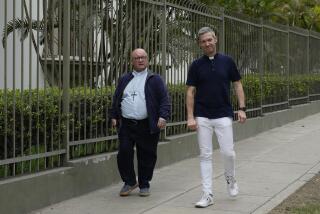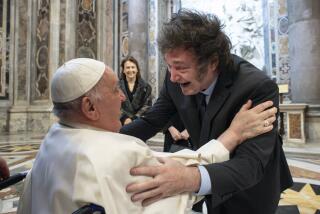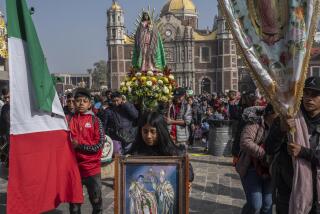Beatifications lay bare an old divide
VATICAN CITY — Bitter memories of Spain’s civil war were on center stage here Sunday as the Vatican put 498 slain Spanish priests and nuns from that divisive era on the path to sainthood.
The Mass recognizing the Catholic men and women killed around the time of the 1936-39 civil war was the largest beatification ceremony in church history. Thousands of pilgrims who traveled from Spain filled St. Peter’s Square, waving yellow and red national flags and pictures of the newly beatified, whom the church considers to be martyrs.
“For a Catholic Spain, they died,” read one huge banner.
However, the beatifications have stirred controversy in Spain, where critics accuse the Vatican of playing politics by recognizing one side of the war’s protagonists.
Moreover, the timing of the ceremony, and the fact it was held at the Vatican with an appearance by Pope Benedict XVI, was seen by many as an ideologically motivated gesture of support for a Catholic Church at loggerheads with the current leftist Spanish government.
The church says the priests and nuns, as well as a handful of lay religious, were killed by pro-leftist forces because of their Catholicism -- “heroic witnesses of the faith,” as the pope called them Sunday.
Many in Spain’s Catholic Church sided with the Fascists led by Gen. Francisco Franco, who overthrew the elected leftist government, won the war and ruled as a dictator for nearly four decades, granting wide power and influence to the church.
Spain remains deeply polarized, and is struggling tortuously to come to terms with its past. This week, a hard-fought “historical memory” law goes before the Spanish parliament, acknowledging in the most comprehensive form yet the atrocities of the Franco regime while also giving a nod to those killed for their religious beliefs. It would finance exhumation of Franco-era mass graves, pay reparations to his victims and cancel summary court judgments against opponents of the regime.
The Vatican and organizers contended that Sunday’s ceremony was not political.
“To beatify a martyr, or a group of martyrs, has no political meaning, but only exclusively a religious one,” Spanish Cardinal Julian Herranz, a member of the ultraconservative Opus Dei organization, which is especially dominant in Spain, told an Italian newspaper.
Later Sunday, protesters scuffled with Catholic adherents outside a church known for its association with Opus Dei. The protesters displayed a banner that repeated graffiti that has popped up in Spain: “Those who have killed, tortured and exploited cannot be beatified.”
They accompanied the banner with a replica of Picasso’s Guernica, his famous painting inspired by the Spanish Civil War. The churchgoers tore up the image portraying the horrors of war as the two groups brawled, Italian television reported.
Benedict, unlike his predecessor, John Paul II, rarely presides over beatifications, so his choice to appear Sunday was significant. He did not attend Sunday’s Mass, but as it concluded, he stepped onto his balcony above St. Peter’s Square to bless the audience and salute the martyrs and their followers.
Martyrdom, he said, “is a testimony as important as ever in today’s secularized societies.”
“The beatifications today remind us of the importance of humbly following our Lord even to the point of offering our lives for the faith,” Benedict added.
Spain was once one of the most Catholic countries in Europe. The current government of Prime Minister Jose Luis Rodriguez Zapatero has trimmed Catholic Church budgets in public schools and pushed a liberal social agenda that includes the recent legalization of same-sex marriage and steps to make it easier to obtain abortions and divorces.
Cardinal Jose Saraiva Martins, a Portuguese prelate who heads the Vatican department that oversees the making of saints, led Sunday’s beatification and used it to emphasize Catholic teachings he said were being challenged in today’s Spain, including the need to honor life “from conception” and marriage as solely the union of man and woman.
“We live in an era in which Christians are threatened in their very identity,” he later told Vatican Radio, alluding to the struggle in Spain and adding that the faithful cannot live a “lukewarm Christianity.”
The crowd in St. Peter’s Square turned ecstatic at the pope’s appearance. Many said they felt vindication for their histories.
“I have waited for this day for years,” said Eulalia Caldes, a Spaniard in her 60s whose aunt, Catalina Caldes, was a nun killed in Barcelona on July 23, 1936. A family hid Caldes from militias for a while, then, fearing their own safety, turned her out.
“This is a huge support for our church, which has been a little down lately,” said Aurora Serrano, 60, who came from Toledo, Spain, in support of Liberio Gonzalez, a priest killed in August 1936 at age 40. He was pulled from his home in front of his horrified mother, and his body was eventually riddled with more than 100 bullets, Serrano said.
Carmen Ibanez Sandin, 54, of Salamanca came to Rome with 37 members of her family, all related to Primitivo Sandin, an Augustinian priest killed July 28, 1936, at the age of 43.
As the story goes, Republican forces rounded up Sandin and other members of the order. He begged for the lives of three youths among them, saying that as seminarians they were not priests and had not yet said Mass. With that, the gunmen ordered Sandin to the front of the group and shot him to death.
“They were atheists,” Ibanez Sandin said of the Republicans. “They were against the church -- the worst period for Spain.”
But she also mentioned that within her large family attending Sunday’s event, there were non-practicing Catholics as well as the devout. One couple in the family had not even baptized their child. “It is family that unites us,” she said, her children waving small plastic Spanish flags.
One particularly controversial beatification was that of Father Gabino Olaso Zabala, who was also killed in August 1936. Decades earlier, he was stationed as a missionary in the Philippines, where witnesses said Olaso was involved in the torture of a priest who was said to have supported the rebellion against Spanish occupiers of the nation.
Father Fernando Rojo, the Spanish-born postulator, or handler, of Olaso’s case and that of the other Augustinian priests, said that such background was not important to the martyr’s cause. Whether or not Olaso was a torturer, the key fact is that he died for his faith.
“We are humans, we can have defects, but at the hour of truth, the question is whether he renounced his faith,” Rojo said in an interview ahead of Sunday’s ceremony.
Under church rules, a martyr -- someone killed expressly for his or her Catholicism -- can be beatified without having performed a miracle. To be canonized as a saint, however, the person must be credited with a miracle, usually an unexplainable medical cure.
In Spain, liberal wings of the church and the political establishment complained about the beatification. The United Left’s parliamentary caucus said it was “vengeful” and called on the Spanish church hierarchy to ask forgiveness for its long support of the Franco regime.
Christian Networks, an umbrella organization of pro-left church groups and Catholic grass-roots activists, said: “To forget the thousands of teachers, priests, workers, politicians and so forth who died as victims of the franquista repression is not only injustice but also makes impossible reconciliation and peace.”
--
More to Read
Sign up for Essential California
The most important California stories and recommendations in your inbox every morning.
You may occasionally receive promotional content from the Los Angeles Times.











